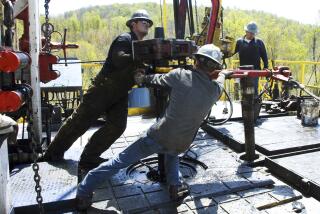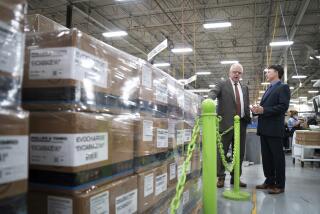On environment, Obama likely to keep walking middle line
WASHINGTON — On election night, President Obama uttered a phrase that thrilled environmentalists.
“We want our children to live in an America that isn’t burdened by debt, that isn’t weakened by inequality,” Obama said, “that isn’t threatened by the destructive power of a warming planet.”
Environmental optimists run the risk, however, of ending up like a kid who expected a puppy for Christmas and got socks instead. Those in industry who think that Obama’s frequent campaign talk about the benefits of oil and gas could mean opening more land to drilling may also be disappointed.
Over the last four years, Obama charted a middle course on the environment that led to landmark pollution rules, growth in clean energy and the continued development of fossil fuels.
For at least much of his second term, there will probably be no sweeping new legislation on climate, air or water pollution, many analysts say, especially with the House of Representatives still controlled by Republicans who view environmental safeguards as economic threats. At the same time, it is unlikely that the administration will throw open vast new swaths of federal lands to oil and gas development.
“This was not a status quo election, but that doesn’t mean the president is going to move on a liberal agenda,” said Joshua Freed, vice president of the clean energy program at Third Way, a center-left Washington think tank. “Instead, what the president has done over the first term is a good road map of what to look for in his second.”
The White House and entities such as the Environmental Protection Agency and Interior and Energy departments will more likely carry on the painstaking work of building out programs and regulations they began in the first term. Some analysts say an incremental approach might stand a better chance than a grand legislative effort to reshape the country’s energy sources, cars and air and water quality.
“There are lots of smaller things you could do, and because they’re not set up as an emblematic fight, you might miss the fact that things are getting done and getting done faster,” said David Goldston, director of governmental affairs for the Natural Resources Defense Council.
The administration has yet to reveal specifics regarding a second-term energy and environment agenda and declined to discuss it, focusing for the moment on a deal with Congress to avert the “fiscal cliff.”
At a Nov. 14 news conference, Obama said of climate change: “We have not done as much as we need to. You can expect that you will hear more from me in the coming months and years about how we can shape an agenda that garners bipartisan support and helps move this agenda forward.”
But the president went on to say that one approach many environmentalists hope to see, a tax on emissions of carbon dioxide, was off the table so far.
The question is how many months and years elapse before that climate agenda emerges. Fiscal and immigration reforms are among Obama’s top priorities. Environmentalists said they would like for him to talk about climate change as often as he does about tax reform.
“We want to see him use the bully pulpit of the presidency to elevate the issue,” said Gene Karpinski, president of the League of Conservation Voters.
For its part, the House Energy and Commerce Committee vowed to challenge any new rules curtailing pollutants including carbon dioxide, the main driver of climate change.
“Republicans will continue to support a true ‘all-of-the-above’ energy strategy that lets all sources of American energy compete,” said the chairman of the Energy and Power Subcommittee, Rep. Edward Whitfield (R-Ky.). “This means stopping regulatory policies that unfairly punish affordable energy sources.”
Industry and environmentalists say decisions the administration will issue over the next few months could be indicators of what to expect over the next four years.
Reductions in greenhouse gas emissions could be set into motion in early 2013, when the EPA is expected to finalize limits on carbon dioxide emissions from new power plants, a step analysts contend will accelerate the existing trend of phasing out coal-fired boilers. The next step would be to address carbon from existing plants, a much tougher fight.
By Wednesday, the EPA is set to issue its final rules on soot, the fine particles emitted by power plants and diesel vehicles that contribute to haze and respiratory ailments. The stringency of the final standard could signal the level of the agency’s regulatory aggressiveness.
As soon as Dec. 17, the EPA is also expected to issue a report examining the impact on water sources of hydraulic fracturing, or fracking, a controversial oil and gas production method. The industry, which asserts that water has never been contaminated by fracking, will be watching for hints of possible federal regulations in the EPA findings.
“Look at what natural gas is doing for greenhouse gas emissions,” said Jack Gerard, chief executive of the American Petroleum Institute, the chief oil and gas lobbyist. Gerard pointed out that the fall in carbon emissions in the U.S. has been largely driven by more power plants burning gas rather than coal. “You can’t be for natural gas and against hydraulic fracturing.”
Gerard also considers the administration’s long-awaited decision on the Keystone XL pipeline from Canada a possible bellwether on energy policy. The oil industry has pushed hard for approval of the pipeline, which would being bring oil from the tar sands of Alberta to refineries on the Gulf Coast, saying it would create jobs and reduce dependence on oil from overseas.
The administration is expected to make its decision in the first quarter of 2013.
Environmentalists rail against the pipeline, contending it would destroy vast parts of Canada, boost carbon emissions and threaten the Midwest’s primary aquifer.
“It’s the first clearest test of how committed the president is to turning away from dirty fuels,” said Michael Brune, executive director of the Sierra Club. “You can’t say you’re committed to fighting climate change and turn around to approve a pipeline that would pump the dirtiest oil in the world.”
More to Read
Sign up for Essential California
The most important California stories and recommendations in your inbox every morning.
You may occasionally receive promotional content from the Los Angeles Times.










